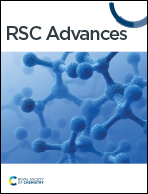Quantitative analysis of fucosylated glycoproteins by immobilized lectin-affinity fluorescent labeling†
Abstract
Human biofluids are often used to discover disease-specific glycosylation, since abnormal changes in protein glycosylation can discern physiopathological states. Highly glycosylated proteins in biofluids make it possible to identify disease signatures. Glycoproteomic studies on saliva glycoproteins showed that fucosylation was significantly increased during tumorigenesis and that glycoproteins became hyperfucosylated in lung metastases, and tumor stage is associated with fucosylation. Quantification of salivary fucosylation can be achieved by mass spectrometric analysis of fucosylated glycoproteins or fucosylated glycans; however, the use of mass spectrometry is non-trivial for clinical practice. Here, we developed a high-throughput quantitative method, lectin-affinity fluorescent labeling quantification (LAFLQ), to quantify fucosylated glycoproteins without relying on mass spectrometry. Lectins with a specific affinity for fucoses are immobilized on the resin and effectively capture fluorescently labeled fucosylated glycoproteins, which are further quantitatively characterized by fluorescence detection in a 96-well plate. Our results demonstrated that serum IgG can be accurately quantified by lectin and fluorescence detection. Quantification in saliva showed significantly higher fucosylation in lung cancer patients compared to healthy controls or other non-cancer diseases, suggesting that this method has the potential to quantify stage-related fucosylation in lung cancer saliva.



 Please wait while we load your content...
Please wait while we load your content...